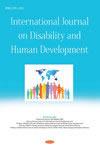The strengths and difficulties questionnaire (SDQ) in autism spectrum disorders
International Journal on Disability and Human Development
Pub Date : 2017-08-28
DOI:10.1515/ijdhd-2016-0025
引用次数: 8
Abstract
Abstract Objective: To investigate the effectiveness of the strengths and difficulties questionnaire (SDQ) in the screening for autism spectrum disorders (ASD) and to find optimal scoring methods. Methods: The SDQ were given to parents of 4–12-year-old children with ASD (n=67), internalizing (n=49), externalizing disorders (n=87), and to a community sample (n=114). The total difficulties score and five subscales scores were compared between the four groups. Two additional scoring methods were calculated: prosocial behavior score minus peer relation problems score and sum of prosocial behavior score and emotional symptoms score. Receiving operating characteristics (ROC) analysis was used to find an effective way of screening for ASD. Results: All five subscales of the SDQ differed significantly between the ASD and the community samples. Only prosocial behavior and emotional symptoms subscales scores in the ASD group differed significantly from both internalizing and externalizing disorders groups (p<0.001). The total difficulties score reliably differentiated the ASD group from the community sample, but not from children with psychiatric disorders. Additional scoring methods’ problems showed the best area under the curve (AUC) in ROC analysis. Conclusion: The SDQ discriminates those with ASD well from other children with and without psychiatric disorders. Applying of additional algorithms is more effective rather than using the total difficulties or subscales scores alone.自闭症谱系障碍的优势和困难问卷(SDQ)
摘要目的:探讨优势与困难问卷(SDQ)在自闭症谱系障碍(ASD)筛查中的有效性,寻找最佳评分方法。方法:对4-12岁ASD(n=67)、内化障碍(n=49)、外化障碍(n=87)儿童的父母和社区样本(n=114)进行SDQ。比较四组之间的总困难得分和五个分量表得分。另外计算了两种评分方法:亲社会行为得分减去同伴关系问题得分和亲社会行为评分与情绪症状得分之和。接受操作特征(ROC)分析用于寻找筛选ASD的有效方法。结果:ASD和社区样本的SDQ的五个分量表均有显著差异。ASD组只有亲社会行为和情绪症状分量表得分与内化障碍组和外化障碍组有显著差异(p<0.001)。总困难得分可靠地将ASD组与社区样本区分开来,但与患有精神障碍的儿童区分开来。其他评分方法的问题在ROC分析中显示出最佳曲线下面积(AUC)。结论:SDQ能很好地将ASD儿童与其他有或无精神障碍的儿童区分开来。应用额外的算法比单独使用总难度或分量表得分更有效。
本文章由计算机程序翻译,如有差异,请以英文原文为准。
求助全文
约1分钟内获得全文
求助全文

 求助内容:
求助内容: 应助结果提醒方式:
应助结果提醒方式:


